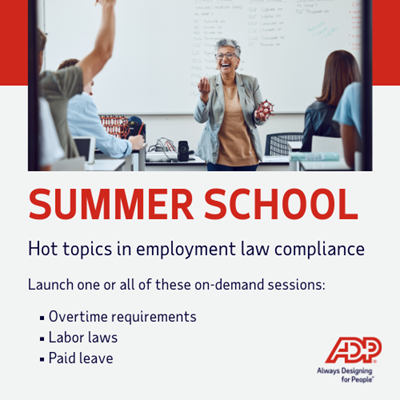Navigating U.S. Labor Law: Key Insights for Employers

Understanding the labor law landscape is crucial for HR professionals and business leaders. Labor law governs the relationship between employers and groups of employees, focusing on collective actions and union interactions. It addresses collective bargaining, union activities, and protected concerted activities, distinguishing it from employment law, which deals with individual issues like discrimination and wage disputes.
Employers must be aware of the National Labor Relations Act (NLRA), which protects employees' rights to discuss wages, working conditions, and other employment-related topics without fear of retaliation. Recognizing these protections is essential to avoid actions that could be viewed as threats or coercion against employees exercising their rights.
In a recent webcast, "Understanding the labor law landscape: Implications and considerations," Kevin Skelly, senior counsel at ADP, offered employers a primer on U.S. labor law.
This webcast is one of a three-part series, Summer school: Hot topics in employment law compliance, available now on-demand.
This article will explore highlights from the presentation, such as key aspects of labor law, recent cases, and best practices for maintaining compliance which can help foster a fair workplace environment.
Overview of U.S. labor law and NLRB enforcement
Labor law in the United States is primarily governed by federal statutes, particularly the National Labor Relations Act (NLRA). The NLRA guarantees employees the right to self-organization, to form, join, or assist labor organizations, and to engage in protected concerted activities for collective bargaining or mutual aid. These rights are limited to non-supervisory employees, but supervisors and managers can influence the employer's compliance with labor laws.
Section 7 of the federal NLRA is the main section that deals with the rights of employees and this section of the NLRA is often referenced in employer policies," Skelly says. He added that there are two critical points about Section 7. One is that the National Labor Relations Act applies to most private employers in the U.S.
"It's a common misconception that labor law is just an issue for unionized workforces, but that's not true."
"Second point is that the rights of the National Labor Relations Act are limited to non-supervisory employees," Skelly says. "Therefore, supervisors and people managers are excluded from these rights. However, what supervisors and managers say and do can be imputed to them and to the employer. It's important that our supervisors and managers act appropriately and don't violate the Act."
The National Labor Relations Board (NLRB) is the independent federal agency that enforces the NLRA. It consists of a five-person board that decides disputes and a general counsel who investigates and prosecutes alleged violations. The NLRB's focus and interpretation of labor laws can change significantly based on the political landscape.
Skelly said that recent changes in the NLRB's leadership and guidance memos indicate a shift in focus, affecting areas such as non-compete agreements, remedies for NLRA violations, and the rights of student athletes.
Understanding protected concerted activity and compliance strategies
Understanding protected concerted activity is essential for employers to navigate labor law effectively. This concept of concerted activity allows non-supervisory employees to collectively address work-related issues such as wages, bonuses, work conditions, and safety. Activities include discussing these topics with coworkers, sending mass communications, and raising concerns with employers, government agencies, or the media. Even a single employee can engage in protected concerted activity if acting on behalf of a group or attempting to induce group action. These protections are crucial for maintaining compliance and avoiding potential labor law issues.
The National Labor Relations Act (NLRA) prohibits employers from threatening, disciplining, or coercing employees in exercising their rights. Examples of prohibited actions include disciplining employees for union activities, promising benefits to discourage union membership, or threatening to close the office if employees join a union. Employers must also avoid questioning employees about their union sentiments or surveilling their union activities.
"Employers should not engage in any "TIPS" – no Threats, no Interrogation, no Promises, and no Surveillance," Skelly says.
Recent NLRB decisions, such as McLaren McComb and Stericycle, have clarified labor law protections. The McLaren McComb decision ruled that overly broad confidentiality and nondisparagement provisions in severance agreements violate the NLRA, requiring employers to tailor these provisions narrowly to protect confidential and trade secret information. The Stericycle decision eliminated the balancing test for workplace policies, making it easier for employees to challenge policies that could infringe on their Section 7 rights.
"These decisions highlight the importance of regularly reviewing and updating workplace policies to help ensure compliance," said Skelly.
Best practices for labor law compliance
Labor law violations can have significant repercussions, including employee reinstatement, monetary fines, and notices admitting violations, which can impact a company's reputation. Businesses must proactively address labor law compliance to avoid these severe consequences.
Skelly emphasized the importance of adopting best practices such as:
- Increasing HR visibility
- Promptly addressing complaints
- Ensuring consistent enforcement of policies
- Fostering a sense of community and
- Selecting managers with good communication skills and emotional intelligence
Recent decisions by the NLRB highlight the importance of regularly reviewing and updating company policies.
Training for new employees and managers is essential to equip them with the skills needed to handle business and people-related issues effectively. By addressing employment law issues promptly, businesses can prevent them from escalating into labor law disputes, thereby maintaining a compliant and harmonious workplace.
Why employers must take labor law compliance seriously
"All business and HR leaders should have a basic understanding of labor law principles, particularly the concept of protected concerted activity," Skelly says. "This foundational knowledge helps foster a fair and compliant workplace."
Understanding labor law is essential for HR and business leaders to effectively manage their workforce and stay compliant with federal regulations. The evolving landscape of labor law enforcement necessitates continuous vigilance and adaptability.
Learn more by launching the summer school on-demand webcast anytime.




